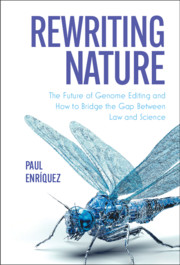Book contents
- Rewriting Nature
- Rewriting Nature
- Copyright page
- Dedication
- Summary of Contents
- Contents
- Figures
- Foreword
- Acknowledgments
- Table of Cases
- Abbreviations
- 1 A Momentous Time for Humankind
- 2 How an Idea Became a Reality
- 3 What Is Genome Editing?
- 4 Molecular Paraphernalia
- 5 What Can Genome Editing Be Used for?
- 6 Redesigning Food
- 7 Regulating Bioengineered Food
- 8 Redesigning Humanity
- 9 DNA and the Administrative State
- 10 Constitutional Predicaments
- 11 Science, Law, and Policy
- 12 Epilogue
- Index
4 - Molecular Paraphernalia
Published online by Cambridge University Press: 11 June 2021
- Rewriting Nature
- Rewriting Nature
- Copyright page
- Dedication
- Summary of Contents
- Contents
- Figures
- Foreword
- Acknowledgments
- Table of Cases
- Abbreviations
- 1 A Momentous Time for Humankind
- 2 How an Idea Became a Reality
- 3 What Is Genome Editing?
- 4 Molecular Paraphernalia
- 5 What Can Genome Editing Be Used for?
- 6 Redesigning Food
- 7 Regulating Bioengineered Food
- 8 Redesigning Humanity
- 9 DNA and the Administrative State
- 10 Constitutional Predicaments
- 11 Science, Law, and Policy
- 12 Epilogue
- Index
Summary
CRISPR systems are democratizing scientists’ access to new tools required for uncovering future significant scientific, medical, and technological advances. CRISPR–Cas9, however, is not the only tool being used to edit DNA sequences. Much like the use of different types of airplanes and vehicles for human transportation, so too can different tools be used for gene editing. This chapter examines the evolution and development of the different types of modern genome-editing tools that have enabled the targeted manipulation of genetic sequences. In so doing, it elucidates how genome editing is a logical extension of the genetic manipulation enabled by pioneer recombinant-DNA techniques. The chapter argues that genome editing exists today because recombinant-DNA technology and molecular cloning were developed, promoted, and refined to give rise to avant-garde molecular tools. As it progresses, the chapter allows the reader to rummage through the genome-editing toolbox and focuses on examining the advantages and disadvantages of four distinct categories of genome editing: (1) chemistry-based systems; (2) viral-based editing; (3) nucleases that rely on protein-DNA interactions for DNA targeting—such as meganucleases, zinc-finger nucleases, and TALE nucleases; and (4) RNA-guided, DNA-nuclease systems, which comprise CRISPR–Cas systems.
Keywords
- Type
- Chapter
- Information
- Rewriting NatureThe Future of Genome Editing and How to Bridge the Gap Between Law and Science, pp. 111 - 140Publisher: Cambridge University PressPrint publication year: 2021



